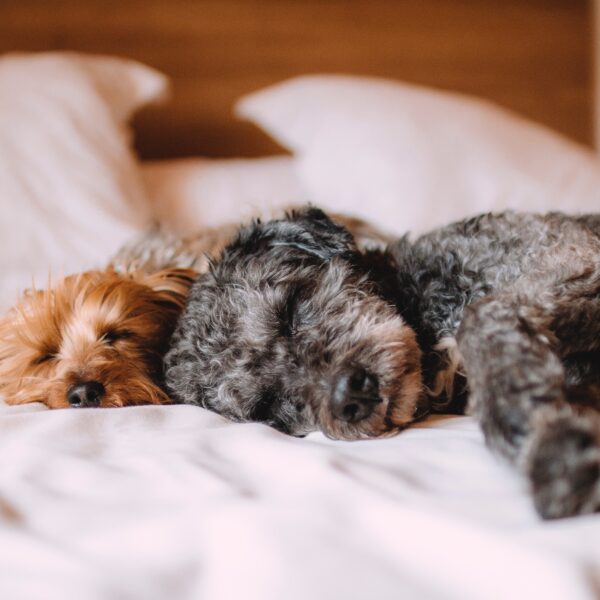For dog accessories that sound so simple, there is an overwhelming number of different collars and leads. While some choices come down to personal preference for you and your pet, it is really important to get a collar that fits just right. Too loose and your dog could slip free, too tight and it can cause discomfort or even injury to their neck. Read our guide on how to pick.
Sizing for a dog collar
Measuring up your dog’s neck is easiest with a soft tape measure, like the ones you would find in a sewing kit. For those of us who don’t have a sewing kit, or the skills to use one, the next best thing is a bit of ribbon or string, plus a ruler. Gently wrap this around your pet’s neck at the point where the collar should sit, and then compare the length to your ruler. The usual rule of thumb is to add 2 inches, just over 5cm in today’s language, to get your pet’s collar size. For really tiny doggos such as pups or toy breeds, you might only need to add 1 inch, and for large breed dogs 3 inches might be better. You can then compare these measurements to a brand’s dog collar size chart to get the best fit for your pet.
Dog collars often have adjustable sizing, especially those with a more traditional dog collar buckle. You should be able to fit two fingers underneath the collar (maybe 1 for toy breeds and 3 for large breeds), which should be loose enough to be comfortable without risking your dog slipping the collar on a walk.
If you are choosing a collar for a pup that is still growing, it is really important to check the sizing regularly and make sure the collar has not become too tight. It can work well to get an adjustable collar that fits well on its smallest setting at purchase, so that it can be loosened as your puppy grows. Once it is starting to look a bit tight on the loosest setting, it is time to get a new collar.
Width of collar is also important. Generally, collars for larger breed dogs will be wider as this can help with strength and durability. If your dog pulls on the lead, a wider collar might suit them better as it will distribute pressure over a wider surface area, which can help to reduce the risk of injury and discomfort. However, wider collars also tend to be heavier which is why smaller breeds tend to suit narrower options.

Types of dog collar
There are some broad categories of collars, although styles can vary within these. A standard collar is most commonly used, sometimes referred to as a flat collar. These should be comfy for most pets as long as they are fitted correctly, and your pet does not pull excessively on the lead.
A martingale collar can be a popular choice for breeds with small necks, or those where neck size is not very different to head circumference, so a traditional collar might slide off. Examples would be whippets and greyhounds. A martingale is essentially a cross between a standard collar and a slip collar. However, a key difference lies in the fact that there is a built-in limit to how tight the collar can go.
Head collars look similar to what you would see on a horse! They can help to reduce pulling and associated pressure on the neck. However, they must be fitted correctly to avoid excess pressure on the skin and facial nerves. Owners should also take care not to pull back too sharply on their pet’s head.
There are a few more controversial types, including the prong collar. These are not usually recommended as they promote negative training methods, and are not endorsed by most UK pet welfare organisations. Choke chains should also be avoided as these can cause damage to your dog’s neck. A fabric slip collar/lead is also unsuitable for long-term use, but may be useful for short periods of time, such as during a vet visit, for extra security. The best advice is to avoid these types of collars unless a pet specialist recommends their use for a specific reason.
Other things to think about when choosing a dog lead and collar include the time of day and weather. If you will be walking during dawn/dusk then a reflective collar can be a good option, or you might prefer a full-on glowing collar if it is properly dark outside. If it is particularly rainy, a waterproof option might be best to avoid a soggy neck. Dog collar name tags are also a legal requirement and should include your name and address at a minimum. Many owners also add their contact number.

Types of dog lead
Standard, extendable, harness leads and more… there’s almost as many options for your pet’s lead as their collar. Take a look at our comprehensive guide.
Regular checks
It is important to check your dog lead and collar regularly to make sure it is in good condition and still fit for purpose. Some naughty hounds can chew on each other’s collars causing them to fray, but there will also be a certain amount of usual wear and tear.
What to do if you aren’t sure
Unsure whether to opt for a dog collar or harness? There are some specific medical conditions where a vet may suggest a harness is more suitable than a dog lead and collar, to reduce pressure on your pet’s throat. Otherwise, it is generally down to personal preference, with some owners finding that harnesses better suit their needs. However, these also need to be fitted correctly or they can cause injury. If you have any questions about choosing the correct size and style of dog collar for your pet, you can speak to your local pet shop specialist for expert advice and to help measure up your pet.
Happy dog walking!
Love your pets? So do we! Sign up below to stay in the know about our pet advice and freebies…


